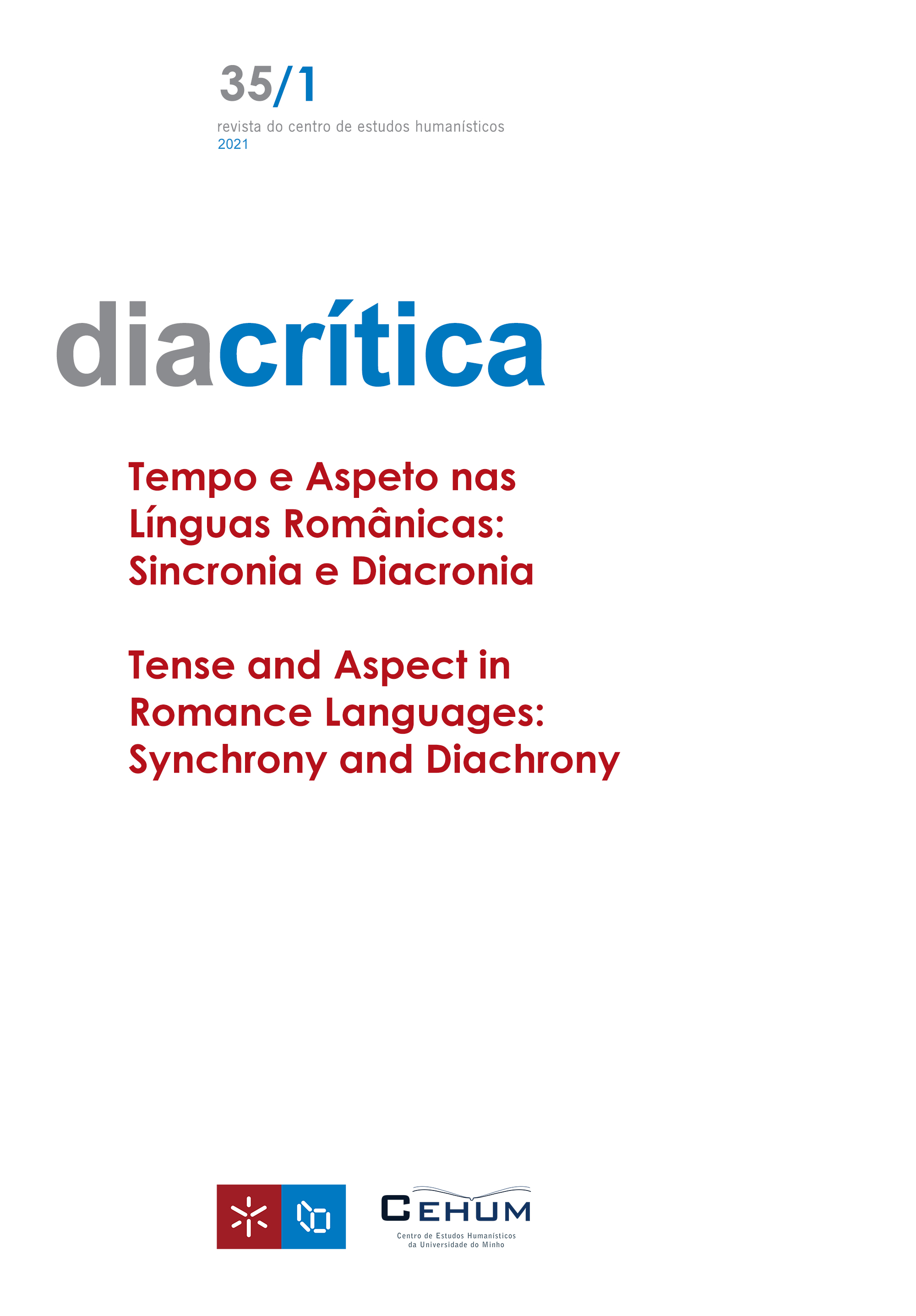Estrutura escalar em classes acionais As propriedades aspectuais visíveis para a gramática
DOI:
https://doi.org/10.21814/diacritica.5116Palavras-chave:
Dimensões aspectuais graduais de eventos, Semântica formal, Classes acionais, Modificadores de grauResumo
Empregamos os fatos sobre o licenciamento de pouco, muito, bastante e bem (de maneira) em sintagmas verbais como ferramenta para identificar as dimensões de evento escalares projetadas pelas classes de Vendler (1957), cuja validade os fatos atestam. Adotamos, na linha da semântica formal, a teoria de graus de Kennedy e McNally (2005), e o Princípio da Economia Interpretativa (Kennedy 2007) para tratar da distribuição e interpretação desses advérbios modificadores de graus. Defendemos que pouco, muito e bastante selecionam semanticamente dimensões quantitativas de escala aberta, o que explica sua agramaticalidade com accomplishments e achievements, enquanto bem (de maneira) seleciona dimensões qualitativas, apresentando um comportamento peculiar com achievements.
Referências
Beavers, J. (2008). Scalar complexity and the structure of events. In J. Dölling, T. Heyde-Zybatow & M.Schäfer (Eds.), Event structures in linguistic form and interpretation (pp. 245–265). Berlin: Mouton de Gruyter. DOI: https://doi.org/10.1515/9783110925449.245
Caudal, P., & Nicolas, D. (2005). Types of degrees and types of event structures. In C. Maienborn & A. Wöllstein (Eds.), Event arguments: Foundations and applications (pp. 277–300). Berlin: De Gruyter. https://doi.org/10.1515/9783110913798.277 DOI: https://doi.org/10.1515/9783110913798.277
Comrie, B. (1976). Aspect: An introduction to the study of verbal aspect and related problems (Vol. 2). Cambridge: Cambridge University Press.
Davidson, D. (1969). The individuation of events. In N. Rescher (Ed.), Essays in honor of Carl G. Hempel (pp. 216–234). Springer, Dordrecht. DOI: https://doi.org/10.1007/978-94-017-1466-2_11
Di Sciullo. A., & Slabakova, R. (2005). Quantification and aspect. In H. Verkuyl, H. de Swart & A. van Hout (Eds), Perspectives on aspect – Studies in theoretical psycholinguistics (Vol. 32, pp. 61–80). Springer, Dordrecht. https://doi.org/10.1007/1-4020-3232-3_4 DOI: https://doi.org/10.1007/1-4020-3232-3_4
Dini, L., & Bertinetto, P. M. (2006). Punctual verbs and the linguistic ontology of events. Quaderni del Laboratorio di Linguistica, 9, 123–160.
Doetjes, J. S. (1997). Quantifiers and selection (Doctoral dissertation, Rijksuniversiteit te Leiden, Leiden).
Doetjes, J.S. (2007). Adverbs and quantification: Degrees versus frequency. Lingua, 117(4), 685–720. https://doi.org/10.1016/j.lingua.2006.04.003 DOI: https://doi.org/10.1016/j.lingua.2006.04.003
Dowty, D.R. (1979). Word meaning and Montague grammar. Dordrecht: Reidel. DOI: https://doi.org/10.1007/978-94-009-9473-7
Fleischhauer, J. (2016). Degree gradation of verbs. Düsseldorf: Düsseldorf University Press. https://doi.org/10.1515/9783110720273 DOI: https://doi.org/10.1515/9783110720273
Foltran, M. J. (2002). Predicados secundários: Restrições semânticas. Revista Letras, 58, 265–278. https://doi.org/10.5380/rel.v58i0.18361 DOI: https://doi.org/10.5380/rel.v58i0.18361
Gehrke, B., & Castroviejo, E. (2016). Good manners: On the degree effect of good events. Proceedings of Sinn und Bedeutung, 20, 252–269.
Gomes, A. (2018). Restrições aspectuais à distribuição do advérbio baixo “muito”. Cadernos de Estudos Linguísticos, 60(1), 198–221. https://doi.org/10.20396/cel.v60i1.8649885 DOI: https://doi.org/10.20396/cel.v60i1.8649885
Gomes, A., & Delduque, J. (2019). Um estudo sobre o licenciamento e a interpretação de" pouco" em português do Brasil (PB). Revista de Estudos da Linguagem, 27(3), 1489–1530. https://doi.org/10.17851/2237-2083.27.3.1489-1530 DOI: https://doi.org/10.17851/2237-2083.27.3.1489-1530
Gomes, A., & Sanchez-Mendes, L. (2015). Degree modification in Brazilian Portuguese and in Karitiana. ReVEL, 13(9), 5-32.
Hay, J., Kennedy, C., & Levin, B. (1999). Scalar structure underlies telicity in degree achievements. Proceedings of SALT IX, 127–144. https://doi.org/10.3765/salt.v9i0.2833 DOI: https://doi.org/10.3765/salt.v9i0.2833
Katz, G. (1995). Stativity, genericity, and temporal reference (Ph.D. dissertation, University of Rochester, New York).
Katz, G. (2003). Event arguments, adverb selection, and the Stative Adverb Gap. In E. Lang, C. Maienborn & C. Fabricius-Hansen (Eds.), Modifying adjuncts (pp. 455-474). https://doi.org/10.1515/9783110894646.455 DOI: https://doi.org/10.1515/9783110894646.455
Kennedy, C. (2007). Vagueness and grammar: The semantics of relative and absolute gradable adjective. Linguistics and Philosophy, 30(1), 1–45. https://doi.org/10.1007/s10988-006-9008-0 DOI: https://doi.org/10.1007/s10988-006-9008-0
Kennedy, C., & McNally, L. (2005). Scale Structure, Degree Modification, and the Semantics of Gradable Predicates. Language, 81(2), 345–381. https://doi.org/10.1353/lan.2005.0071 DOI: https://doi.org/10.1353/lan.2005.0071
Kratzer, A. (1989). Individual-level vs. Stage-level predicates. Papers on quantification, 2, 42–45.
Krifka, M. (1998). The origins of telicity. In S. Rothstein (Ed.), Events and grammar (pp. 197-235). Dordrecht: Springer. DOI: https://doi.org/10.1007/978-94-011-3969-4_9
Moens, M. (1987). Tense, aspect and temporal reference (Ph.D. dissertation, The University of Edinburgh, Edinburgh).
Piñón, C. (2007). Aspectual composition with degrees. In L. McNally & C. Kennedy (Eds.), Adjectives and adverbs: Syntax, semantics and discourse (pp. 183–219). Oxford: Oxford University Press.
Rothstein, S. (2004). Structuring Events: An essay on the semantics of lexical aspect. Oxford: Blackwell. DOI: https://doi.org/10.1002/9780470759127
Rothstein, S. (2008a). Telicity, atomicity and the Vendler classification of verbs. In S. Rothstein (Ed.), Theoretical and crosslinguistic approaches to the semantics of aspect (pp. 110–43). Amsterdam: John Benjamins. DOI: https://doi.org/10.1075/la.110.04rot
Rothstein, S. (2008b). Two puzzles for a theory of lexical aspect: Semelfactives and degree achievements. In J. Dölling, T. Heyde-Zybatow & M. Schäfer (Eds.), Event structures in linguistic form and interpretation (pp. 175–198). Berlin: De Gruyter. https://doi.org/10.1515/9783110925449. DOI: https://doi.org/10.1515/9783110925449.175
Sanchez-Mendes, L. (2015). A modificação de grau no domínio verbal em Karitiana: Evidência para escalas indeterminadas. LIAMES: Línguas Indígenas Americanas, 15(1), 125–147. https://doi.org/10.20396/liames.v15i1.8641499 DOI: https://doi.org/10.20396/liames.v15i1.8641499
Smith, C. (1991). The parameter of aspect. Dordrecht: Kluwer. DOI: https://doi.org/10.1007/978-94-015-7911-7
Tescari Neto, A. (2015). Por que advérbios altos não são diagnósticos para o movimento do verbo?. Lingüística, 31(2), 27–46.
Vendler, Z. (1957). Verbs and times. The Philosophical Review, 66(3), 143–160. https://doi.org/10.2307/2182371. DOI: https://doi.org/10.2307/2182371
Verkuyl, H. J. (1993). A theory of aspectuality – The interpretation between temporal and atemporal structure. Cambridge: Cambridge University Press. DOI: https://doi.org/10.1017/CBO9780511597848
Verkuyl, H. J. (1999). Aspectual issues – Studies on time and quantity. Stanford: CSLI Publications.
Downloads
Publicado
Como Citar
Edição
Secção
Licença
Direitos de Autor (c) 2023 Ana Paula Quadros Gomes, Ana Carla do Nascimento Gomes, Bruno de Souza Medeiros

Este trabalho encontra-se publicado com a Creative Commons Atribuição-NãoComercial 4.0.










